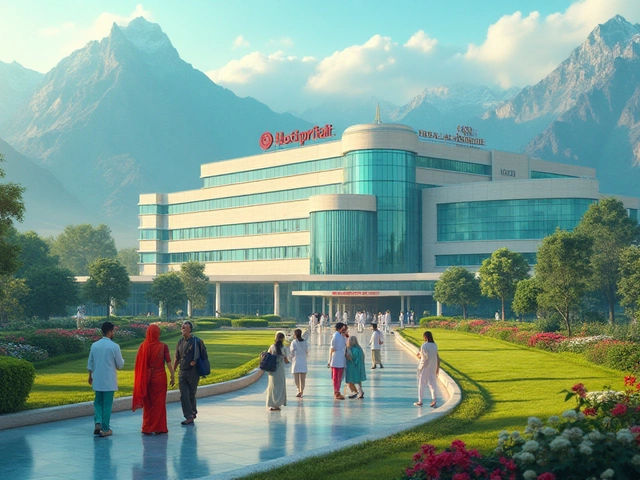When we think of hospitals, the image that often comes to mind is of sterile hallways and bustling medical staff. However, some hospitals in the United States are redefining these spaces, transforming them into stunning architectural accomplishments. They serve as a testament to how a welcoming environment can enhance the healing process and patient satisfaction.
For medical tourists, choosing a hospital isn't just about technology and expertise. The appearance and ambiance of a healthcare facility can significantly influence a patient's experience. This article will guide you through some of the prettiest hospitals in the US, showcasing how beauty isn’t just skin deep but rather a fundamental component in modern hospital design.
- Introduction to Hospital Aesthetics
- Top Beautiful Hospitals in the US
- The Role of Architecture in Healing
- Tips for Medical Tourists
Introduction to Hospital Aesthetics
In a surprising evolution, hospitals have emerged as more than just places for healing ailments. The prettiest hospitals in the US demonstrate how aesthetics play a role in the healthcare landscape today. These innovative designs aren't just about visual appeal; they are integral to creating calming environments that aid recovery. Hospitals are now being planned and designed with just as much care as any top-tier resort. The aim is not only to cater to patients' medical needs but to also engage their senses in an atmosphere of tranquility and peace.
Imagine entering a hospital that looks like it belongs in an art gallery. The walls tell a tale of creativity, with vibrant colors and shapes that calm the mind. This is not just wishful thinking; many hospitals across the United States have shifted to aesthetic-forward designs. They incorporate natural lighting, green spaces, and contemporary art into their daily existence. This is further supported by a growing body of research indicating that pleasant surroundings impact recovery times positively.
In the realm of medical tourism, the demand for beautiful hospitals has also been influenced by patient-centered care philosophy. A hospital's visual aesthetic can alleviate stress, which is crucial for patients who travel hundreds or thousands of miles away from their homes for treatment. In a 2017 study published by The Center for Health Design, it was revealed that hospitals with aesthetically pleasing designs reported better overall patient satisfaction rates. It’s an intriguing blend of art and science that bridges the gap between healthcare and hospitality.
"A hospital should be a place that heals not only the body but also the soul," architect Michael Heinlein said. His words reflect a broader movement towards integrating healing environments into medical infrastructure.
Recognizing the importance of beauty in function, architects and designers now work alongside medical professionals to ensure that patients aren’t just being treated—they’re being nurtured. Simple choices, like large windows framing scenic views or rooftops converted into serene gardens, can significantly impact mood and recovery. The result is a harmonious blend where functionality does not suffer for beauty and vice-versa.

Top Beautiful Hospitals in the US
Beauty is often in the eye of the beholder, but when it comes to hospitals, there are certain structures that captivate everyone. Take the legacy of the prettiest hospital US, the Cedars-Sinai Medical Center in Los Angeles, which has long been admired not only for its medical excellence but also for its aesthetically pleasing design. Nestled within the heartbeat of Hollywood, Cedars-Sinai features architecture that blends the modern with timeless elegance, making it a beacon of hope and healing in more ways than one. Besides its inpatient suites that offer panoramic views of the city, the center's art installations and serene gardens contribute significantly to a peaceful healing process for patients and their families.
Another hospital that deserves special mention is the Cleveland Clinic Miller Family Pavilion. This structure is a marvel, representing how intentional design affects recovery. Its expansive windows blur the lines between indoors and outdoors, flooding spaces with natural light, which studies have shown can improve mood and speed healing. This beautiful hospital in Cleveland has consistently been ranked high for patient satisfaction. Its unique use of plants and living walls serves not just as décor but as part of an integrated approach to healing that harkens back to a connection with nature. "Environments matter in healthcare," says Dr. Thomas Graham, former Chief Innovation Officer at Cleveland Clinic. "They can truly enhance the one-on-one experience between patient and provider."
To add to this prestigious list, the Boston Children’s Hospital provides a stellar example of how bright and inviting spaces can transform healthcare settings for the youngest patients. Each area is vividly designed to comfort and engage children through vibrant colors and interactive features. This setting vastly differs from standard clinical environments, making it one of the most welcoming places for pediatric care. A powerful blend of functionality and playfulness ensures that young patients find solace during their hospital stays, often reducing anxiety not only for them but also for their parents and caretakers.
Last but not least is the Mayo Clinic in Rochester, Minnesota, where medical tourism is thriving due to its seamless blend of patient care and architectural grace. The clinic's use of open spaces, carpeted floors to reduce noise, and artwork that's both inspiring and comforting epitomizes their patient-focused vision. The Gonda Building, a centerpiece of the Mayo Clinic campus, offers a stunning atrium where patients and visitors can relax and rejuvenate. These design elements, combined with top-notch medical technology and a stellar reputation for healthcare services, make the Mayo Clinic a primary destination for those seeking treatment in a healing environment that cares for the soul as much as it does the body.
The partnership between functional architecture and patient care in these hospitals demonstrates the importance of aesthetics in the healing process. As more people consider healthcare not just as a service but an experience, such hospitals stand out as leaders, turning the potential anxiety of a hospital visit into a more holistic and comforting journey. This movement reflects a broader trend within the healthcare industry as they aim to integrate mind and body wellness principles into their physical environments, making these institutions much more than just places of treatment, but destinations of healing and rejuvenation.

The Role of Architecture in Healing
In the realm of modern medicine, the significance of architecture in hospitals extends beyond mere aesthetics; it plays a pivotal role in the healing process. A thoughtfully designed hospital can significantly contribute to the well-being of its patients. Studies have shown that environments infused with natural light, calming colors, and strategic use of space can reduce stress and promote quicker recovery. In some of the most beautiful hospitals in the US, these elements are not just additions, but core components of the design strategy employed to create extraordinary healing environments.
One such remarkable example is the design of the Lucile Packard Children's Hospital situated in Palo Alto. This facility is adorned with gardens and green spaces that bring nature closer to patients' lives. Green spaces have been linked to lower anxiety levels and improved concentration, especially in pediatric care where calming influences are essential. Research also suggests that patients with a view of trees or gardens in their rooms require less pain medication compared to those without such views. Such architectural choices are not merely decorative but instrumental in enhancing patient comfort and accelerating the recovery process.
"Access to nature and green views have increasingly been noted in literature for their restorative impacts on mental health" - Healthcare Design Magazine
Incorporating elements of the natural landscape into hospital design is sometimes referred to as 'biophilic design.' This approach involves the use of natural materials, lighting, and even shapes that mimic nature in hospitals. The aim is to bridge the gap between the built environment and the natural world, providing sensory connections that may improve patient outcomes. Access to sunlight and views of natural landscapes can lead to better sleep patterns in patients and a boost in mood, which is critical for recovery.
Evidence-based design, a concept that integrates the best available research to design that supports health outcomes, plays a crucial role in the aesthetics of these hospitals. It ensures that each design decision, from the layout of patient rooms to the art on the walls, is backed by data to create a therapeutic environment. The Cleveland Clinic's Heart & Vascular Institute, recognized for its focus on both form and function, takes advantage of its river views and sunlit spaces to enhance patients' therapeutic experiences. The emphasis on patient-centric care, driven by data and empathy, has set a new standard in hospital aesthetics.
Moreover, modern hospitals are increasingly designed with flexibility in mind. This means that spaces can be easily reconfigured to suit changing healthcare needs, without sacrificing beauty or serenity. Sustainability is also a key consideration, with many hospitals striving to minimize their environmental footprint through eco-friendly design elements. The integration of solar panels, use of recycled materials, and energy-efficient lighting systems contribute significantly to the functionality and beauty of the healthcare facilities.
In summary, the prettiest hospitals in the US exemplify how architecture can be a powerful ally in medical care. The thoughtful blend of aesthetics, nature integration, and flexible, sustainable designs not only makes these hospitals appealing but also transforms them into healing havens. These spaces reflect a forward-thinking vision where architectural beauty meets functional brilliance, ensuring that patients receive not just medical attention but an experience aimed at holistic healing.

Tips for Medical Tourists
Embarking on a journey to receive medical care is a significant decision and knowing how to prepare can make the experience much smoother and more rewarding. For those considering a visit to one of the prettiest hospitals in the US, understanding a few key aspects can greatly enhance your medical tourism adventure. First, research is your best ally. Begin by compiling detailed information about potential hospitals, including patient reviews, available facilities, the expertise of medical staff, and technological capabilities. Knowing what to expect can reduce anxiety and allow you to focus on your health and recovery. Consider factors such as hospital accreditation, which can be an indicator of quality and safety standards.
Another practical tip is to plan your logistics carefully. Traveling for medical purposes is not like a regular trip; it's essential to account for travel arrangements that accommodate your medical needs. Coordinating with your chosen hospital regarding airport pickups, special travel requirements, and accommodation options is crucial. Additionally, prepare for cultural differences you might encounter. Understanding local customs and language nuances can help mitigate culture shock and improve your communication with healthcare providers. Many hospitals offer translation services, so inquire ahead to find out what's available.
Financial considerations should not be overlooked when planning medical tourism. Budgeting for both expected and unexpected costs is crucial. Ensure that you comprehend the fee structure of your chosen hospital, which includes not just the treatment costs but also accommodation, medication, and follow-up care. Some hospitals offer all-inclusive packages that can simplify this process. Investigating insurance coverage options for medical tourism is also advisable, as some policies may cover cross-border treatments.
Recovery is an integral part of any medical trip, and choosing a facility that offers a serene and comforting environment can greatly aid in this process. The design and ambiance of a hospital play a role in this, as studies show that patients in aesthetically pleasing settings tend to recover faster. Dr. Roger Ulrich, a leading figure in healthcare design research, has famously stated,
"A hospital's appearance can have tangible effects on recovery times and patient mood."This insight highlights the importance of the physical environment in healing.
Lastly, connecting with fellow patients who have undergone similar experiences can provide support and guidance. Many hospitals offer forums or support groups where past and prospective patients can communicate. These interactions not only provide emotional support but also offer insights into the hospital's practices, helping prospective patients make informed decisions. The journey of medical tourism can be daunting, but with the right preparation, it can lead to transformative experiences and better health outcomes.





